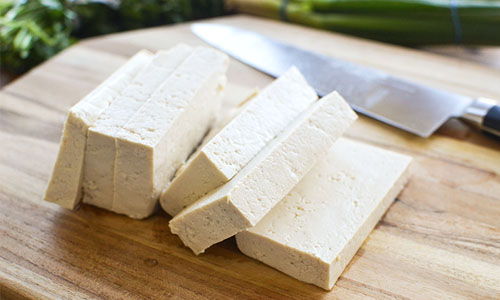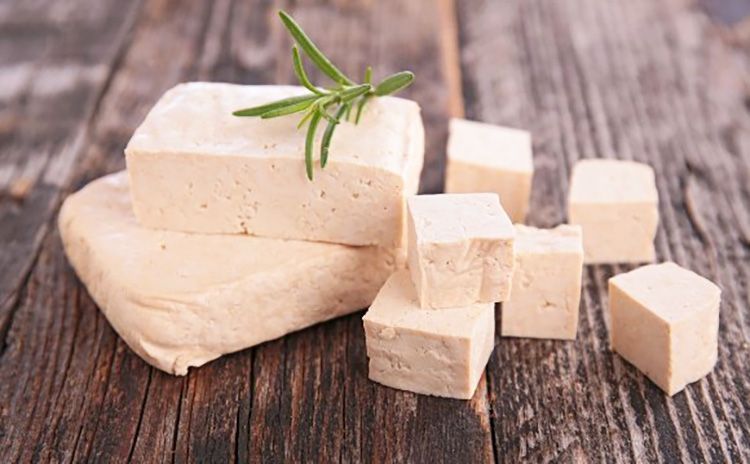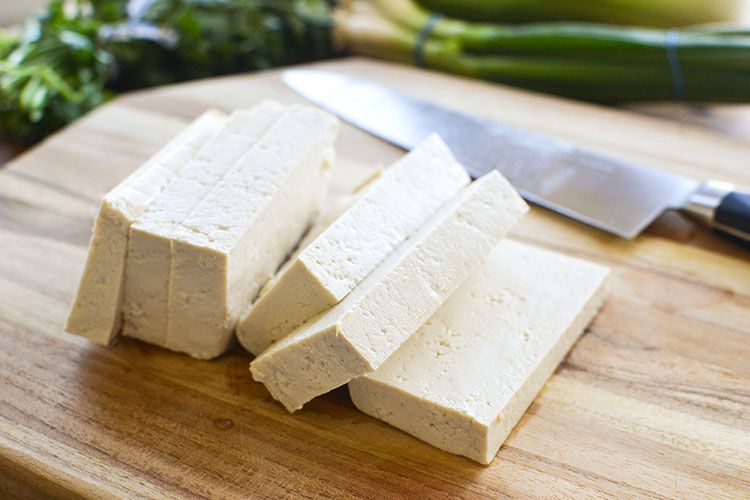

Tofu is one of those foods that sparks debate. Some can’t rave enough about its versatility and health benefits. Others think it is a genetically-modified poison to be avoided at all costs. This may leave you wondering whether tofu should be a part of your diet or not.
This article takes a detailed look at tofu and its health effects, both good and bad.
What is Tofu?
Tofu is a food made of condensed soy milk that is pressed into solid white blocks. It originated in China and the process is quite similar to how cheese is made.
Rumor has it that a Chinese cook discovered tofu more than 2,000 years ago by accidentally mixing a batch of fresh soy milk with nigari.
Nigari is what remains when salt is extracted from seawater. It is a mineral-rich coagulant used to help tofu solidify and keep its form.
This is what fresh tofu looks like:

Most of the world’s soybeans are currently grown in the U.S. and a very large proportion is genetically modified.
Although genetically modified foods are controversial, research has so far not found them to be harmful to human health (1).
However, if you’re worried about it, simply opt for non-GMO, organic tofu brands.
Bottom Line: Tofu is made from condensed soy milk, in a process similar to how cheese is made. Whether made from GMO soybeans or not, tofu is generally considered safe for human consumption.
Tofu Contains Many Nutrients
Tofu is high in protein and contains all the essential amino acids your body needs. It also contains fats, carbs and a wide variety of vitamins and minerals.
One 3.5-oz (100-gram) serving of tofu contains:
- Protein: 8 grams.
- Carbs: 2 grams.
- Fiber: 1 gram.
- Fat: 4 grams.
- Manganese: 31 percent of the RDI.
- Calcium: 20 percent of the RDI.
- Selenium: 14 percent of the RDI.
- Phosphorus: 12 percent of the RDI.
- Copper: 11 percent of the RDI.
- Magnesium: 9 percent of the RDI.
- Iron: 9 percent of the RDI.
- Zinc: 6 percent of the RDI.
This comes with only 70 total calories, which makes tofu a highly nutrient-dense food.
However, the micronutrient content of tofu can vary, depending on the coagulant used to make it. Nigari adds more magnesium, while precipitated calcium increases the calcium content.
Bottom Line: Tofu is low in calories, but high in protein and fat. It also contains many important vitamins and minerals.
Tofu Also Contains Antinutrients
Like most plant foods, tofu contains several antinutrients.
These include:
- Phytates: Phytates can reduce the absorption of minerals such as calcium, zinc and iron.
- Lectins: Lectins are proteins that can cause nausea and bloating when uncooked, improperly cooked or eaten in excess.
However, soaking or cooking soybeans can inactivate or eliminate some of these antinutrients.
Sprouting soybeans before making tofu reduces phytates by up to 56 percent and trypsin inhibitors by up to 81 percent, while also increasing protein content by up to 13 percent (2).
Fermentation can also reduce anti-nutrients. For this reason, make sure to add fermented probiotic soy foods to your diet, such as miso, tempeh, tamari or natto.
Bottom Line: Tofu contains antinutrients like trypsin inhibitors, phytates and lectins. It is possible to degrade these antinutrients, which increases the nutritional value of tofu.
Tofu Contains Beneficial Isoflavones
Soybeans contain natural plant compounds called isoflavones.
These isoflavones function as phytoestrogens, meaning that they can attach to and activate estrogen receptors in the body.
This produces effects similar to the hormone estrogen, although they are weaker.
The two main isoflavones in soy are genistein and daidzein and tofu contains 20.2–24.7 mg of isoflavones per 3.5-oz (100-gram) serving (3).
Many of the health benefits of tofu are attributed to the high isoflavone content.
Bottom Line: All soy-based products contain isoflavones, which are believed to have various health benefits.
Tofu May Reduce the Risk of Heart Disease
Only a few studies specifically look at tofu’s effects on heart health.
However, research has shown that a high intake of legumes, including soy, is linked to lower rates of heart disease (4).
We also know that soy isoflavones can reduce blood vessel inflammation and improve their elasticity (5).
One study found that supplementing with 80 mg of isoflavones per day for 12 weeks improved blood flow by 68 percent in patients who were at risk of stroke (6).
Taking 50 grams of soy protein per day is also associated with improved blood fats and an estimated 10 percent lower risk of heart disease (7).
What’s more, in post-menopausal women, high soy isoflavone intake was linked to several heart protective factors. These included improvements to body mass index, waist circumference, fasting insulin and HDL cholesterol (8).
Finally, tofu also contains saponins, compounds thought to have protective effects on heart health (9).
Animal studies have shown that saponins improve blood cholesterol and increase the disposal of bile acids, both of which can help lower heart disease risk (10).
Bottom Line: Whole soy foods like tofu can improve several markers of heart health. This may lead to a reduced risk of heart disease.
Tofu is Linked to Reduced Risk of Some Cancers
Studies have looked into the effects of tofu on breast, prostate and digestive system cancers.
Tofu and Breast Cancer
Research shows that women who eat soy products at least once a week have a 48–56 percent lower risk of breast cancer (11, 12).
This protective effect is thought to come from isoflavones, which have also been shown to positively influence the menstrual cycle and blood estrogen levels (13, 14).
It seems that exposure to soy during childhood and adolescence may be most protective, but that’s not to say that intake later in life is not beneficial (15).
In fact, research shows that women who ate soy products at least once a week throughout adolescence and adulthood had a 24 percent lower risk of developing breast cancer, compared to those who ate soy during adolescence alone (16).
One often-heard criticism of tofu and other soy products is that they may increase breast cancer risk. However, a two-year study in which post-menopausal women consumed two servings of soy per day failed to find an increased risk (17).
Other studies report similar findings, including a review of 174 studies, which found no link between soy isoflavones and increased risk of breast cancer (18, 19, 20).
Tofu and Cancers of the Digestive System
One study observed that higher intakes of tofu were linked to a 61 percent lower risk of stomach cancer in men (21).
Interestingly, a second study reported a 59 percent lower risk in women (22).
What’s more, a recent review of 633,476 participants linked higher soy intake to a 7 percent lower risk of cancer of the digestive system (23).
Tofu and Prostate Cancer
Two review studies found that men consuming higher amounts of soy, especially tofu, had a 32–51 percent lower risk of developing prostate cancer (24, 25).
A third review agrees with this, but adds that the beneficial effects of isoflavones may depend on the amount consumed and type of gut bacteria present (26).
Bottom Line: Research indicates that soy has a protective effect against breast, digestive and prostate cancers.
Tofu May Reduce the Risk of Diabetes
Over the past 10 years, several cell and animal studies have shown that soy isoflavones can have benefits for blood sugar control (27, 28).
In one study of healthy post-menopausal women, 100 mg of soy isoflavones per day reduced blood sugar levels by 15 percent and insulin levels by 23 percent (29).
For diabetic post-menopausal women, supplementing with 30 grams of isolated soy protein lowered fasting insulin levels by 8.1 percent, insulin resistance by 6.5 percent, LDL cholesterol by 7.1 percent and total cholesterol by 4.1 percent (30).
In another study, taking isoflavones each day for a year improved insulin sensitivity and blood fats, while reducing the risk of heart disease (31).
However, these findings are not universal. A recent review of 24 human studies found that intact soy protein—as opposed to isoflavone supplements or protein extracts—was more likely to lower blood sugar (32, 33).
Bottom Line: Tofu may have positive effects on blood sugar control, but more studies are needed to confirm this link.
Other Potential Health Benefits of Tofu
Due to its high isoflavone content, tofu may also have benefits for:
- Bone health: Scientific data suggests that 80 mg of soy isoflavones per day may reduce bone loss, especially in early menopause (34, 35).
- Brain function: Soy isoflavones may have a positive influence on memory and brain function, especially for women over 65 (36).
- Menopause symptoms: Soy isoflavones may help reduce hot flashes. However, not all studies agree (37, 38, 39, 40, 41).
- Skin elasticity: Taking 40 mg of soy isoflavones per day significantly reduced wrinkles and improved skin elasticity after 8–12 weeks (42).
- Weight loss: In one study, taking soy isoflavones for 8–52 weeks resulted in an average weight loss of 10 lbs (4.5 kg) more than a control group (43).
Bottom Line: Due to its high isoflavone content, tofu may have benefits for a variety of health conditions. However, more research is needed.
Tofu May Cause Problems for Some People
Eating tofu and other soy foods every day is generally considered to be safe. That being said, you may want to moderate your intake if you have:
- Kidney or gallbladder stones: Tofu contains a good amount of oxalates, which may worsen oxalate-containing kidney or gallbladder stones.
- Breast tumors: Due to tofu’s weak hormonal effects, some doctors tell women with estrogen-sensitive breast tumors to limit their soy intake.
- Thyroid issues: Some professionals also advise individuals with poor thyroid function to avoid tofu due to its goitrogen content.
However, not all researchers agree. Some even say that consuming soy foods like tofu can benefit people with kidney stones (44).
In addition, a recent report from the European Food Safety Authority (EFSA) concluded that soy and soy isoflavones pose no concerns for breast and uterine cancers or thyroid function (45).
Nevertheless, researchers agree that infants should not be exposed to soy isoflavones, which may disrupt the development of reproductive organs (26, 46).
Although this has not been studied well in humans, some animal studies suggest that high amounts of soy may interfere with fertility (47, 48).
Bottom Line: Eating tofu is safe for most people. If you’re worried about negative health effects, then double-check with your healthcare provider.
How to Select Tofu or Make Your Own
Tofu can be purchased in bulk or individual packages, refrigerated or not.
You can also find it dehydrated, freeze-dried, jarred or canned.
Generally, not a lot of processing is necessary to make tofu, so choose varieties that have short nutrition labels.
You can expect to see ingredients like soybeans, water, coagulants (such as calcium sulfate, magnesium chloride or delta gluconolactone) and maybe some seasoning.
Once opened, tofu blocks need to be rinsed prior to being used.
Leftovers can be stored in the refrigerator, covered with water. Stored this way, tofu can be kept for up to one week—just make sure you change the water often.
Tofu can also be frozen, in its original package, for up to five months.
Finally, making your own tofu is also a possibility. All you need are soybeans, lemon and water. If you’d like to give it a try, check out this simple video:
Bottom Line: Tofu can be found in a variety of shapes and forms. Homemade tofu is also surprisingly easy to make.
Tofu is a Healthy Food
Tofu is high in protein and many healthy nutrients.
Eating tofu may protect against a variety of health conditions, such as heart disease, diabetes and even certain cancers.
This article was reposted from our media associate Authority Nutrition.
YOU MIGHT ALSO LIKE
25 Easy Ways to Get More Fermented Foods in Your Diet
Read This if You Love Eating Fish But Worry Your Getting Too Much Mercury Exposure
8 Health Benefits From Drinking Kombucha Tea
Atlantic Salmon Is All But Extinct as a Genetically Eroded Version of Farmed Salmon Has Taken Over

 233k
233k  41k
41k  Subscribe
Subscribe 
